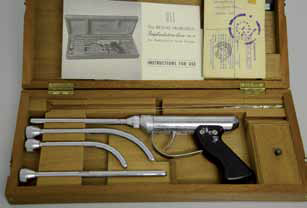© Hong Kong Academy of Medicine. CC BY-NC-ND 4.0
REMINISCENCE: ARTEFACTS FROM THE HKMMS
Gold grain implantation gun: Royal Marsden Hospital
Kerrie L MacPherson, PhD
The Kadoorie Institute, The University of Hong Kong
Member, Education and Research Committee, Hong Kong Museum of Medical Sciences Society
Non-surgical cancer treatments have undergone a
major shift since Röntgen discovered X-rays in 1895
and radiation was first used for cancer treatment
in 1899. A more targeted regimen using external
beam therapy and brachytherapy became the gold
standard, and the advent of chemotherapy made
further significant improvements in treating the
disease.
The gold grain implantation gun in the Hong
Kong Museum of Medical Sciences’ collection (Fig) was an innovation in brachytherapy for the treatment
of difficult or inoperable cancers of the prostate,
bladder, uterus, pelvis, stomach and, particularly
relevant for Hong Kong, nasopharyngeal carcinomas
(NPC). The treatment worked by implanting short
sections or ‘grains’ of radioactive gold encased in
platinum into malignant neoplasms.1 The Cantonese
populations of Hong Kong and South China have
the highest incidence of NPC in the world. Although
trending downwards in Hong Kong over the past 40
years, in 2010, it ranked as the sixth most common
cancer in men and thirteenth in women, accounting
for 3.3% of all new cancer cases. Although external
radiotherapy is the first line of defence, the sites
of NPC make it exceedingly complex to target
persistent and recurrent disease.2

Figure. The gold grain implantation gun was delivered to Queen Mary Hospital from the Medical Supply Association (London) on 3 May 1966 (Serial No. 260, patent No. 744691). It was donated by the Hospital to the Hong Kong Museum of Medical Sciences in 1996
The implantation gun was designed by
researchers, Hodt, Sinclair, and Smithers at the
Cancer Hospital (Free) in England in 1952.3 It was
modified in 1965 by Jones, Taylor, and Stedeford
to ameliorate the risks of radiation exposure to
the hands, fingers, and eyes of the operator. It was
slimmer, could be autoclaved, and had a more
efficient ejection of radioactive gold grains to the
specified site compared with the older model.4
This modified and improved ‘gun’ is the Museum’s artefact.
The Free Cancer Hospital located in
Westminster, London was originally founded in
1851 by Dr William Marsden whose wife died from
cancer. It was the first hospital in the world dedicated
to cancer research. It was given a Royal Charter of
Incorporation in 1910 and was renamed the Royal
Marsden Hospital in 1954 in recognition of the
founder’s vision and dedication to finding answers to
‘the study of the disease for ...... we know absolutely
nothing about it’.
Hong Kong has benefited from the innovative
research of the Royal Marsden Hospital and astutely
applied the results to ameliorating the suffering of
those affected by cancer. The gold grain implantation
gun is one of the significant milestones in the long
history of research performed at the hospital.
References
1. Mould RF, Tai TH. Nasopharyngeal carcinoma: treatments and outcomes in the 20th century. Br J Radiol 2002;75:307-39. CrossRef
2. Kwong DL, Wei WI, Cheng AC, et al. Long term results of radioactive gold grain implantation for the treatment of persistent and recurrent nasopharyngeal carcinoma. Cancer 2001;91:1105-13. CrossRef
3. Hodt HJ, Sinclair WK, Smithers DW. A gun for interstitial implantation of radioactive gold grains. Br J Radiol 1952;25:419-21. CrossRef
4. Jones CH, Taylor KW, Stedeford JB. Modifications to the Royal Marsden Hospital gold grain implantation gun. Br J Radiol 1965;38:622-4. CrossRef

